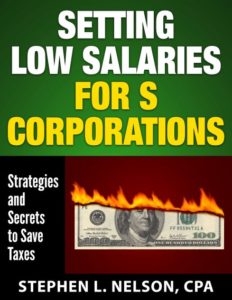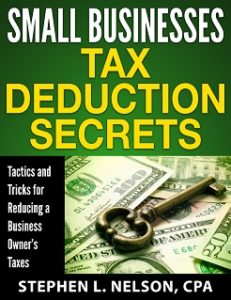 S corporation shareholder-employees regularly ask for S corporation salary rules. And tax accountants, wanting to help, try to provide them.
S corporation shareholder-employees regularly ask for S corporation salary rules. And tax accountants, wanting to help, try to provide them.
Unfortunately, however, there really aren’t great salary rules for S corporations.
The only real “rule” is to pay a shareholder reasonable compensation, by which the IRS rule makers mean pay a shareholder-employee the wages the labor market says his or her job is worth.
Nevertheless, I will talk about S corporation salary rules here. People want the information. And if you’re forced to use one of these rules, you may as well know what’s wrong and right with the rule you’re using.
Note: I’m going to discuss the rules in descending salary value order… We’ll get the formulas that deliver the worst results out of the way first.
S Corporation Salary Rule #1: 100% of the Profits
The very worst of the S corporation salary rules that people bandy about is the rule that says if you’re a one worker, one shareholder S corporation, you ought to pay all of the profits out to the shareholder in the form of wages.
Almost surely, the Internal Revenue Service has no problem with this rule. The rule means you don’t save any payroll taxes with your S corporation.
But this is a dumb rule. You often don’t have to pay out all of your profits as wages.
Some of your profits may get “paid out” to the shareholder-employee in the form of tax-free fringe benefits, for example.
Some of your profits should be retained inside the corporation for working capital.
And possibly some of the profit of the business should be returned to the shareholder as a return on his or her investment.
The upshot? You might need to pay out all of the profits as wages… but most S corporations shouldn’t have to do this. And so you can probably look at using one of the other S corporation salary rules.
S Corporation Salary Rule #2: The FICA Limit
Another common rule is to pay a shareholder-employee the year’s FICA limit or the business profits, whatever is less.
In 2017, for example, the FICA limit equals $137,700. So an S corporation that made this amount or more would pay its shareholder $137,700.
Note: Just so we’re clear here. A business that made $237,700 in profits, so $100,000 more than the FICA limit, would pay salary equal to the FICA limit and then take out that remaining $100,000 as distribution.
This rule probably works pretty well because it results in a generous salary and means the shareholder pays the maximum amount of Social Security taxes. Any S corporation tax savings come from saving Medicare taxes and then what I’m going to call here the “Obamacare” taxes…
But this rule is pretty artificial. And while most jobs pay less than the FICA limit, it’s sort of only accidental if this approach results in reasonable shareholder-employee compensation.
 Tip: I’ve got a good whitepaper that talks about how low you can safely set S corporation salaries in light of the laws and regulations.
Tip: I’ve got a good whitepaper that talks about how low you can safely set S corporation salaries in light of the laws and regulations.
If you’re really serious about setting your shareholder salaries, you might want that resource, which is available here for $100: “Setting Low Salaries for S Corporations” e-book.
But let me also note that sometimes setting a salary to the FICA limit saves you quite a bit of payroll tax.
S Corporation Salary Rule #3: $100,000 a year
Related to this idea of paying a salary equal to the FICA limit, people sometimes arbitrarily set a shareholder-employee wage amount of $100,000.
For example, if an S corporation makes, say, $200,000 for an owner, the S corporation might pay the shareholder $100,000 in wages and then pay out the other, remaining $100,000 in distributions.
As far as S corporation salary rules go, this one probably works okay because it results in a pretty hefty wages amount. (I’ve had an IRS auditor suggest this wages amount during an audit.) But again, the formula result is pretty arbitrary.
Note: As discussed here, it sort of appears that Warren Buffet and Berkshire Hathaway have used this rule in the past.
S Corporation Salary Rule #4: 60% Wages 40% Distributions
For years, probably for decades, accountants have tossed around a seeming logical rule that says 60% of the S corporation’s profit should be paid out as wages and the remaining 40% paid out as distribution.
Superficially, this S corporation salary rule sounds great. But who knows whether it provides a sturdy “reasonable compensation” value. If it does, that result would be only accidental.
I can guess, however, many IRS auditors would accept a 60% wages and 40% distributions approach because it’ll probably produce a wages-like amount and it does appear so darn systematic and rational. (We accountants love things to be systematic and rational!)
S Corporation Salary Rule #5: IRS S Corporation Salary Industry Averages
One other rule of thumb is to use the IRS S corporation salary average, which is available for roughly six dozen industries.
Note: Our “S Corporations Explained” website provides an up-to-date list of these Average S corporation salaries.
Let me just explicitly say that using these fuzzy averages, which come from crunching 1120S Subchapter S tax return data, is a bit sloppy. Some of the assumptions made to calculate the averages are pretty easy to criticize.
But just as an example, if you see that the average S corporation providing investment advisory services pays its shareholders $74,000 annually, you’re probably often going to be okay paying $74,000 a year to shareholder-employees in an average investment advisory firm.
The Real S Corporation Salary Rules
By the way, can I repeat something I said (briefly) at the very beginning? The best rule for setting S corporation salaries for shareholders is to look at what’s reasonable… which means what the firm would need to do is compare what a shareholder-employee earns to what someone else earns to do the same job in a similar sized small business.
 Tip: If you’re researching S corporation salary issues as a way to save a small business payroll taxes, you should also keep in mind that tax law provides small businesses with dozens of powerful tactics for cutting taxes by using tax deductions.
Tip: If you’re researching S corporation salary issues as a way to save a small business payroll taxes, you should also keep in mind that tax law provides small businesses with dozens of powerful tactics for cutting taxes by using tax deductions.
This other approach can be just as effective as the S corporation option…
For more information about how to take advantage of all your deduction opportunities, consider our downloadable e-book “Small Businesses Tax Deduction Secrets“.
Need More Detailed Help?
You may also be interested in three other blog posts we’ve done related to this subject:
S Corporation Salary Safe Harbor
Thank you for sharing such an informative article about S corporation salary rules.